WORLD TRAVEL NEWS ARTICLE
BULGARIA
Bulgaria, a country with a population of around eight million, is on the up. If you visit this charming eastern European country, you’ll find it’s completely different to the country of even ten years ago – albeit slightly more expensive, too.

A glimpse of the Bulgarian countryside
Bordered to the north by Romania and the River Danube, to the east by the Black Sea, Bulgaria also shares borders with Turkey, Greece, Serbia and the former Yugoslav Republic of Macedonia. It’s a picturesque country that encompasses impressive coastlines and mountains – some of the most fashionable new European ski resorts are Bulgarian. There are also plenty of forests and rivers to explore. The main cities have long cast off the old grey Communist-era image and today you’ll find up and coming shopping and dining, along with a good nightlife. Bulgarian is the official language in Bulgaria and they use the Cyrillic alphabet, which can take some getting used to.
There are plenty of well-maintained hiking trails and horse-riding routes around the country, especially around the Rila and Pirin Mountains. If you’re lucky, you might spot a bear, lynx, rare birds and other wildlife.
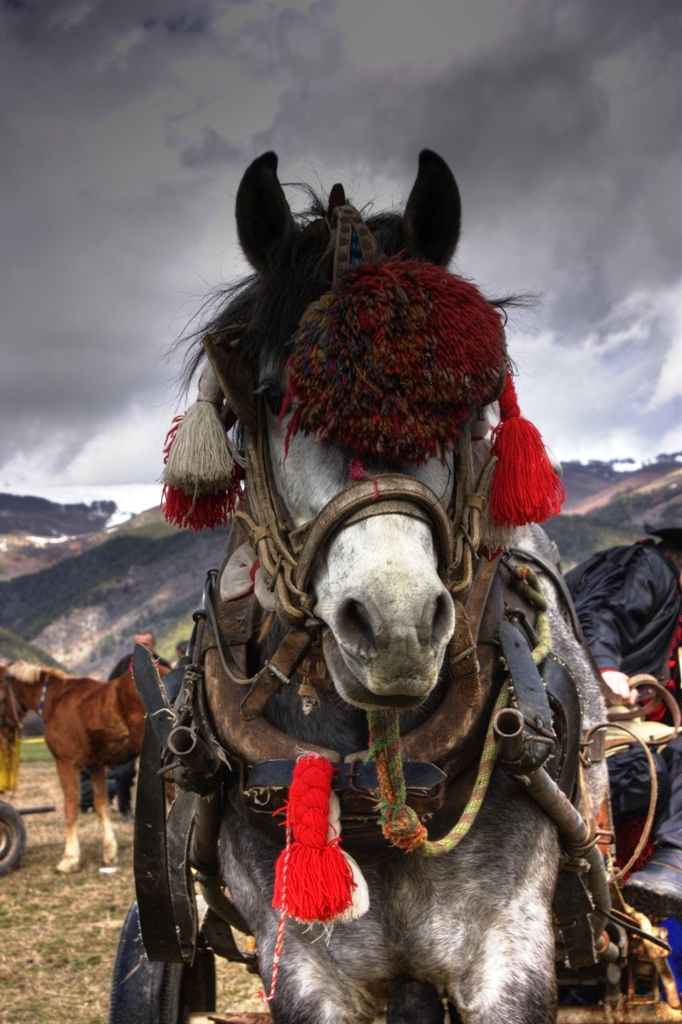
St. Theodore's Day in Trodorovden
If you’re looking for some of the authentic charm of Bulgaria, head out to one of the quaint old villages, where you’ll find some good old fashioned Bulgarian hospitality and some of the well-loved folklore traditions.
History
Bulgaria has an interesting history – it was once a prosperous empire, which stretched to the coastlines of the Black, Aegean and Adriatic Seas. The country has been under foreign control twice in its history, being part of the Byzantine Empire from 1018–1185 and then the Ottoman Empire from 1396 - 1878.
Russia declared war on Turkey, and captured Sofia in 1879. The subsequent Treaty of Stefano ended the war and created an independent Bulgaria - until the Austro-Hungarians and British objected and insisted that Bulgaria was split into the northern half which became a Turkish principality, and the southern half which was semi-autonomous within the Turkish Empire and re-named Eastern Rumelia.
Unsurprisingly the Bulgarians weren't happy and in 1885 there was a coup in Eastern Rumelia which reunited them with northern Bulgaria. The Serbs decided they weren't happy with that either and declared war the same year. They were defeated but this led to another agreement - the two halves of Bulgaria were not allowed to completely unite, and had to stay separate entities - but the Prince of (northern) Bulgaria was made 'governor-general' of Eastern Rumelia. In 1908 the Bulgarians decided they'd had quite enough of this, and Prince Ferdinand announced the complete independence of Bulgaria, becoming King Ferdinand of Bulgaria in the process.
During WWII, Bulgaria became part of the Axis and Sofia was heavily bombed – thousands of buildings were destroyed or damaged. At the end of the war in 1944, Bulgaria became part of the Eastern Bloc. Communist rule industrialised the country, especially Sofia, where factories and apartment blocks sprung up everywhere and the population grew. The legacy of communism after 1989 was high unemployment, hyperinflation and corruption. Some of the old Communist party members still exert influence to this day. Things are on the up though, and Bulgaria joined the EU in January 2007, making it more appealing as a tourist destination and boosting economic growth.
Main Airports
Sofia Airport is 10 kilometres east of Sofia. Regular buses run into to the city, as do taxis, but make sure they use their meter.
Varna Airport is 9 kilometres from Varna. A bus service into the city centre departs every 20 minutes. Taxis are also available.
Burgas (Bourgas) Airport is 8 kilometres from Burgas with a bus service that departs every 20 minutes into the city centre. Taxis are available.
The main seaports are at Burgas and Varna on the Black Sea coast.
Money
The currency in Bulgaria is the Lev (symbol лв) and one Lev = 100 stotinki. The Lev is tied to the Euro at a fixed rate of one Euro = лв1.955.
Money is best exchanged at banks, hotels and independent currency exchange offices. Unofficial exchange offices are best avoided even though they might promise you a ‘better offer’. It’s actually illegal to charge a commission when changing money in the official currency exchange offices, and it’s worth noting that nowhere will accept mutilated, torn or very dirty foreign currency for exchange.
Bulgaria likes to work with cash, and although you can use major credit cards in Sofia and other bigger cities, they aren’t as popular out of the city. There are cash machines across the country but they don’t all take every type of overseas credit or debit card. Traveller’s Cheques aren’t very common, but if you take them, opt for US Dollars, Pounds Sterling or Euros, and some larger hotels will accept them as payment.
Banking hours are generally Monday to Friday 09:00 am - 4:00 pm.
Food and Drink
Bulgarian food is hearty, and similar to a lot of the cuisines of south eastern Europe. The country is famous for its delicious salads, and there’s usually one to go with every meal. Bulgarian cuisine features a lot of especially good dairy produce, indeed it is rumoured that Bulgaria is where yoghurt was first made. There’s evidence that it’s been produced there since 3,000 BC.
Other items you’ll find in abundance on a Bulgarian menu are hot and cold soups, a Bulgarian white brine cheese called ‘sirene’, pastries, and pork, the most common meat used in Bulgarian cuisine. If you’re not feeling adventurous, Bulgaria also offers a choice of restaurants all serving the usual Western European dishes.
Unless you’re eating at a really upmarket hotel, it’s unlikely that a service charge will be added to your bill, and a 10% tip is normal. The legal drinking age is 18.
Shopping
VAT in Bulgaria is 20 % but if you’re coming from outside the EU you can apply to have this refunded. Keep your paperwork and apply at the airport, on your way home.
No longer the austere country of old, Bulgaria is now attracting some of the Western brand names and stores. It’s easy to find fashionable clothes, shoes, cosmetics and up to date gadgets, but don’t expect them to be ultra cheap, as prices aren’t too much different to those in western Europe. The country is a good place to find cheaper replica goods though, and produces its own good quality textiles, wooden and ceramic items and leather goods, if you know where to look. The main shopping areas are to be found in Sofia, on Bulvard Vitosha, ulitsa Graf Ignatiev and ulitsa Rakovski.

Downtown Sofia
The Sofia shopping experience has been brought bang up to date with several refurbishments and new shopping malls – the mall of Sofia is the largest of them, and has everything you’d expect to find in a modern mall including a food court and a crèche. Another mall – CCS – is more of a leisure complex than a heavy shopping destination with six levels of bars, restaurants, an IMAX cinema, and shops selling French fashion and Turkish home ware. If you’re looking for Bulgarian souvenirs your best bet is on the stalls in front of the Alexander Nevski church and the streets close by. For a true taste of Bulgaria, treat yourself to some of the local wines, Melnik, or rakiya (fruit brandy).
Where to go in Bulgaria
Sofia
Sofians love their ballet, opera and theatre, and because they are so good, and cheap, it’s well worth trying to get tickets for one or the other while you’re in Sofia. Just ignore the language difference and enjoy the quality! The city's official arts centre is the Natsionalen Dvorets na Kulturata and boasts concert halls, exhibitions, and the Lumière Cinema. Most of Sofia’s main cultural events happen here.

Boyana Church (Wikipedia)
Boyana Church, which is around 8 kilometres out of the city, is a tiny medieval church, and one of Bulgaria's national treasures. It only reopened in 2000, after 38 years of restoration. While you’re there, marvel at the beautiful 13th-century frescoes, some of the best examples of Bulgaria's medieval art. If you want to visit, you’ll have to be accompanied by a guide and are only allowed in for 10 minutes.
The National History Museum is fascinating, as it traces the development of Bulgaria's cultural, social and political life from prehistoric times up to WWII. The exhibits are labelled in Cyrillic, though, so you might have to ask to find out what’s what.
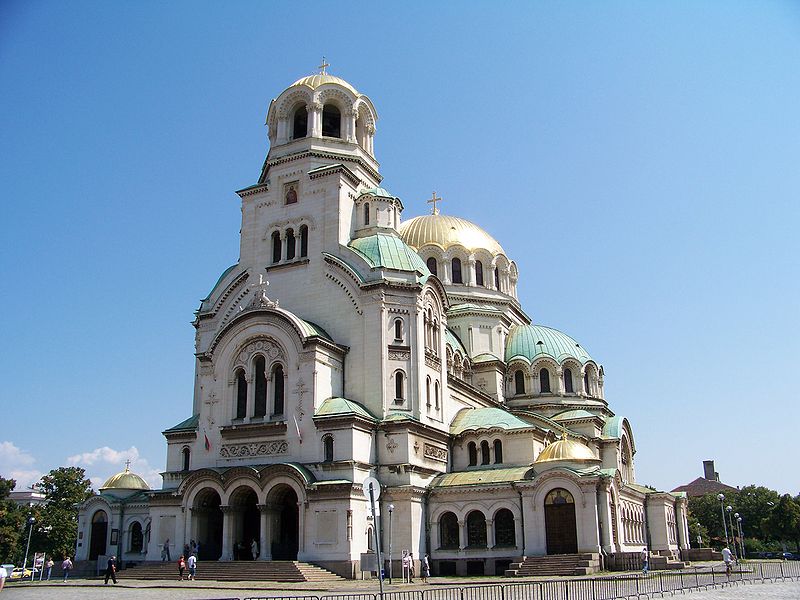
St Alexander Nevski Cathedral (Wikipedia)
St Alexander Nevski Cathedral is one of Sofia’s most famous monuments. It’s a neo-Byzantine structure, with stunning copper and gold domes, built between 1882 and 1912. The cathedral was built as a monument to the Russian soldiers who died in an attempt to liberate Bulgaria from Ottoman rule during the War of Liberation, and takes its name from Alexander Nevski, the patron saint of the family of the Russian Tsar at the time, Alexander II. The Icon Museum, located in the crypt, is home to many fine exhibits which follow the development of Bulgarian icon-painting from the ninth to 19th centuries.
Burgas
Burgas, sometimes written Bourgas, is the fourth largest city in Bulgaria and the largest port on the Black Sea, with pedestrianised boulevards and outdoor cafes which give it a bit of a glamorous, Mediterranean, feel. Many people stay here and use it as a base to travel out to the other resorts, as well as for a spot of bird watching at the nearby tranquil lakes.
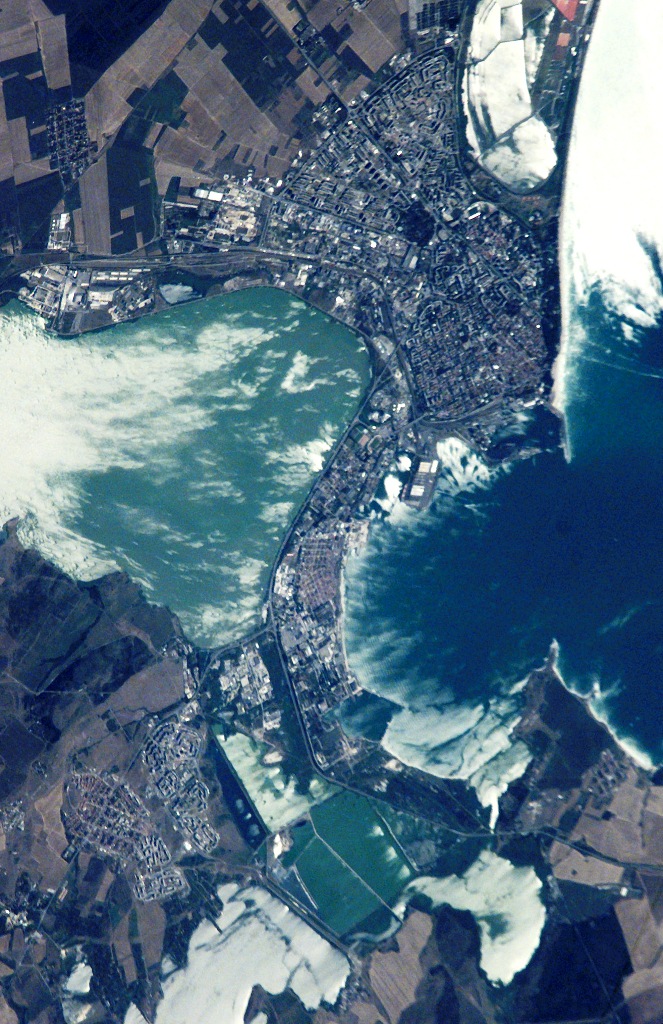
Burgas from space
Burgas has a gorgeous long beach to relax on, and the Marine Par, which is also close, is a good place for a walk – as are the fashionable shopping areas, restaurants and bars. Not really a beach resort as such, Burgas is more popular for its seaside ambience, fun attractions and entertainment. The beach is also great for swimming, and the strong winds make the conditions perfect for trying your hand at wind surfing, although the down side is that you might have to hunt for a while to find anywhere that will actually rent the equipment. You could also try kite-surfing if you head down to the northern end of the beach where it’s less busy.
Rila Monastery and National Park
Rila Monastery, about 120 kilometres from Sofia, is one of the most important cultural sites in Bulgaria, within the Rila National Park and included on the UNESCO list of World Heritage Sites. The first monastery was founded here in the 10th century, and it became a centre for artisans during the Renaissance. Within the complex, the outer walls are decorated with colourful scenes from the Bible, and there is a separate museum which holds some of the remnants of the monastery's previous riches. Also on the site are various craft stalls, a restaurant and snack shop.
The Rila National Park is perfect for hiking, with marked mountain paths through dense pine forests. It’s even possible to book an overnight stay at the monastery, although the accommodation is, not unsurprisingly, frugal.
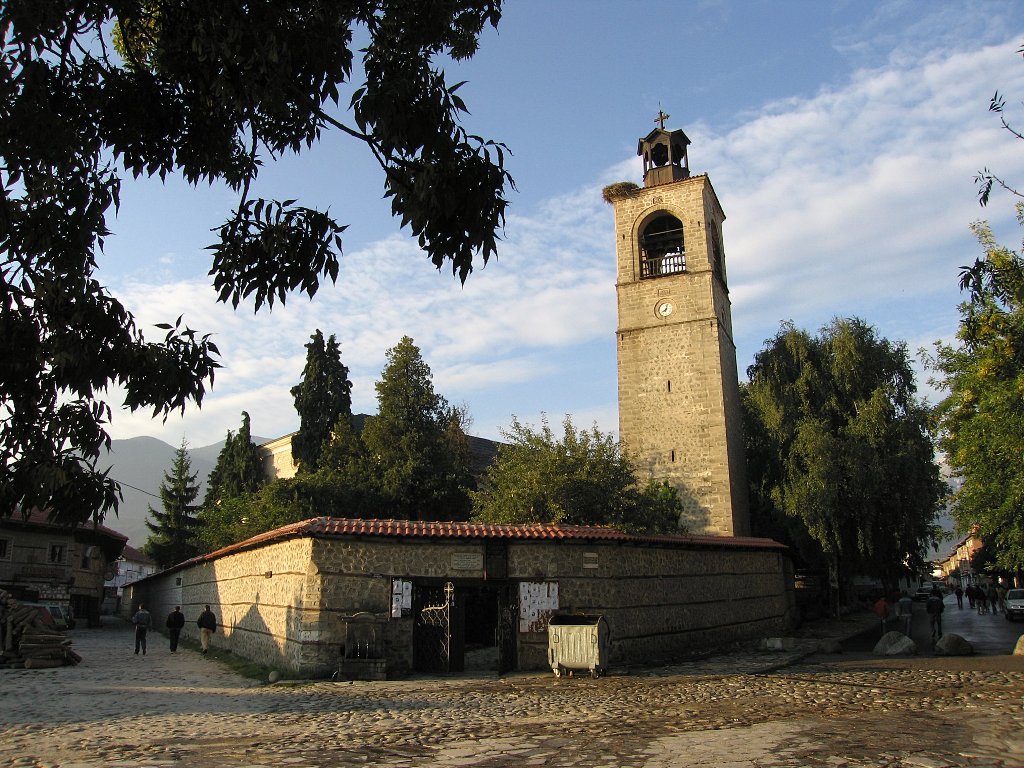
An historic building Bansko's Old Town
Bansko
Bulgaria is gaining a reputation across the world for being a good quality, and excellent value ski destination, but the resort of Bansko has more to it than simply ski lifts and slopes. The town is situated on the River Glazne in the foothills of the Pirin Mountains, close to the Macedonian border and north of Pirin National Park. There’s a delightful old town centre featuring some gorgeous traditional Bulgarian stone and timber houses, traditional cobbled streets and winding roads. However, it’s not all quaint and olde-worlde. Bansko is one of Europe's fastest growing winter holiday destinations, and was nominated to host the 2014 Winter Olympics, but lost out to Russia. Avid skiers will love the quad chairlifts on the mountain, the gondola from the old town to the ski area and the long ski runs back down to the village.

Mount Vitosha
Skiing at Mount Vitosha, Borovets and Pamporovo
Mount Vitosha is the highest ski resort in Bulgaria, and is also famous for rock formations at Zlatnite Mostove. It’s not as touristy as some of the other ski resorts, but it’s popular, with ski runs of various lengths and difficulties, chair and drag lifts and a gondola.
Borovets is Bulgaria's oldest winter resort and home to the highest peak in the Balkans, Mount Musala. Most of the amenities are on the streets between the huge Rila and Samokov hotels. Or you could try the Pamporovo ski resort for cheap skiing in the heart of Bulgaria's Rhodopi Mountains. Pamporovo ski resort is set to become even more popular when the Perelikdevelopment project is completed. The project will increase the number of pistes and their length, and link Pamporovo to the nearby resort of Chepelare.
Trigrad Gorge
Trigrad Gorge is in the Rhodope Mountains, and near the town of Trigrad in Southern Bulgaria. The popular Devil’s Throat cave was created when some of the mountain layers collapsed. You can travel through a tunnel to witness the spectacular waterfalls – the highest underground waterfalls in Europe. Also worth a visit is the Haramiiska cave, or one of the 150 other caves in the region. Unsurprisingly, the area is very popular with local and visiting rock climbers, and if you are interested, there are plenty of companies that are on hand to give you the opportunity to try it for yourself. Birdwatchers also like the Gorge for the rare species that inhabit it.
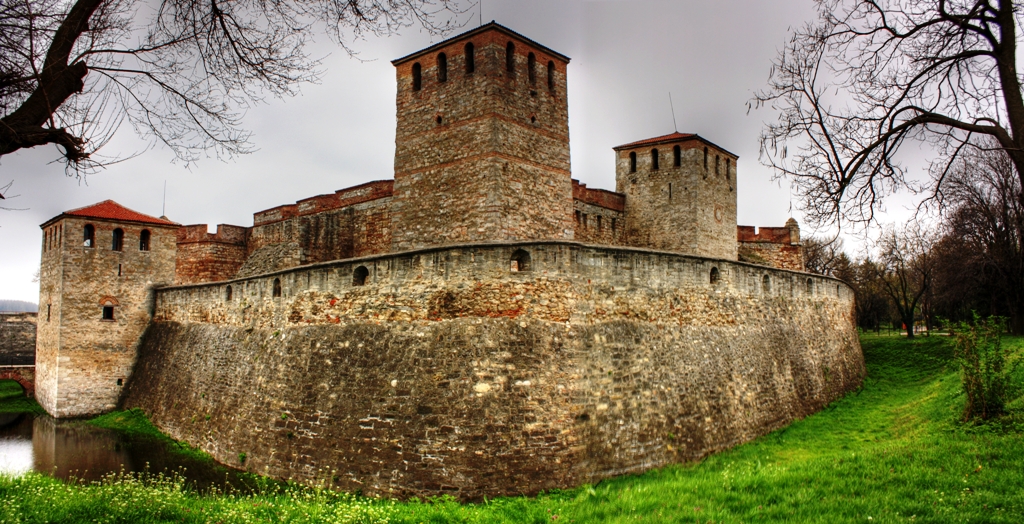
Baba Vida Castle
Baba Vida Castle
Built on the banks of the River Danube in the town of Vidin, the Baba Vida Castle overlooks Vidin from its position on the foundations of an old Roman fortress. The castle was built during the 10th century and is an excellent example of an intact medieval fortress. The castle has protective inner and outer walls and a moat filled with water from the Danube. No longer used to defend the realm, it now hosts theatrical productions during the summer and is often used as a film set. If you want to find out more about the history of the castle, check out the on-site museum.
Varna
Varna, the second biggest city in Bulgaria, is on the Black Sea coast. Featuring a famously long stretch of beach, and a Seaside Park, the city also boasts many fine historical remains, including Roman thermae, and the second largest church in Bulgaria - the Church of the Assumption. Varna also has a reputation in Bulgaria for being a great place to shop, and has plenty of boutiques and jewellery stores open all year round. There’s a large Sea Garden complete with its own amusement park, bouncy castle and mini-golf, and a dolphinarium with daily shows. The nearby National Naval Museum is a good place to head off to if submarines and warships quite literally float your boat, too.
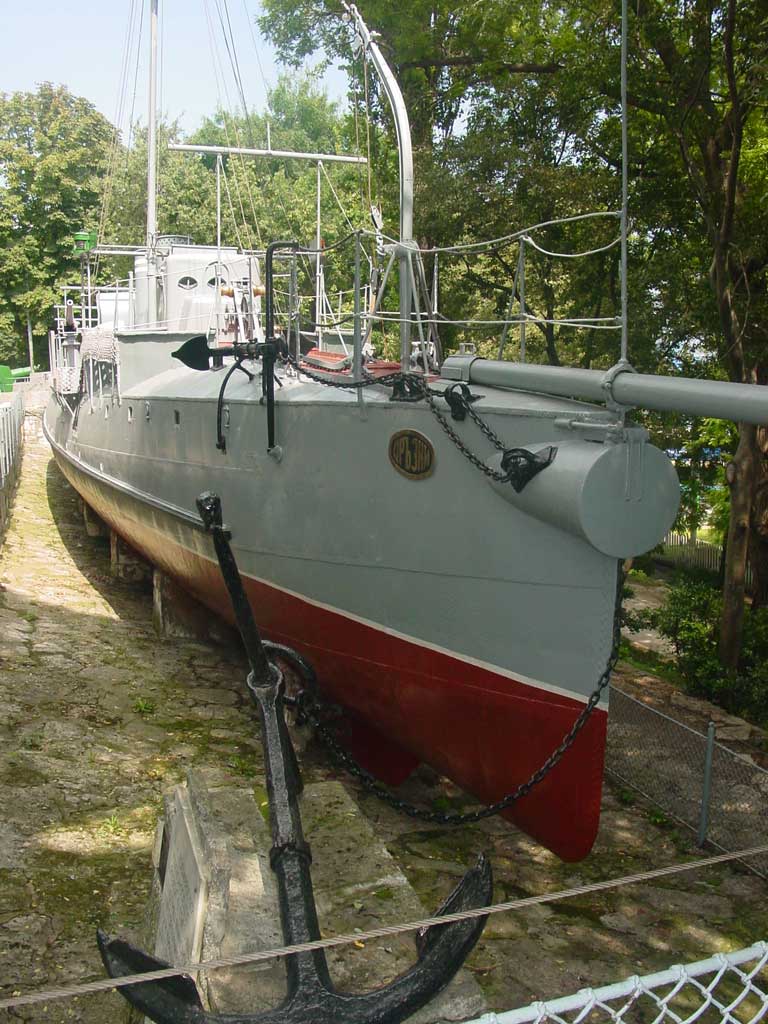
A submarine exhibit
Sea and Sand
Bulgaria is probably as well known, if not better known, for its gorgeous Black sea beaches and resorts, as it is for the ski resorts.

Varna Beach
Golden Sands
One of the Black Sea's most popular beach resorts and not far from Varna, Golden Sands is growing fast, as its popularity with tourists – especially package travellers – increases. There’s a lot of development here, as there is in many of the larger Bulgarian resorts, with lots of hotels and apartments being built so it can be very busy in the tourist season. The main path along the beach front is where most of the action is. In Golden Sands the streets quite literally have no name, so you have to find your way around by hotel. It’s definitely more a resort that will appeal to younger people, with plenty of bars and clubs to choose from, especially popular with German, British and Danish visitors.
Sunny Beach lives up to its name and offers visitors a huge swathe of lovely golden sand as well as several undisturbed months of sunshine between May and September. The resort first came into existence during the communist era, when tourists began to visit the area’s natural mineral baths. More recently the resort has become a bit of a hot spot for British property buyers, who have been snapping up villas, which leads to even more construction work. There are now literally dozens of rows of hotels along the lively waterfront – but what the resort lacks in peace and quiet it certainly makes up for in leisure activities. Take your pick from the trendy restaurants, bars and clubs, and the wide selection of water sports on offer. The beach itself is 8 km long, with a walk way which takes you through shops, bars and restaurants, and other amenities. Sunny Beach is another package holiday paradise, popular with the Brits, Irish and Germans. It’s also a good spot for a family holiday, and the Action Aquapark on the western edge of the resort is a good place for an afternoon or day out with the kids.
If you want a quieter break, you can still go to Sunny Beach; you just need to head off to the slightly more exclusive northern end of the resort.
Varna
Varna has a lovely beach, complete with soft white sand which is just perfect for a spot of sun bathing and relaxing. There’s occasionally a nod towards water sports and beach volleyball – plus there’s a water slide for the children to play on, but it’s not as lively as some of the other more tourist-inclined beaches in Bulgaria.

Varna Bay
All in all, Bulgaria is a good destination for anyone looking for a great value break with the opportunity for a look around an up-and-coming eastern European country. The country has great character, and a mind of its own that doesn’t seem to let it fit any particular ‘Eastern Bloc’ stereotype.
You may also like to read
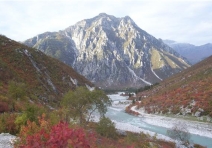
ALBANIA UNWRAPPED
Tour-smart’s own Tim Moore set out to discover what is available for today’s visitors to Albania.

CAMBODIA
Tour-smart involves you in the excitment that is Cambodia. An unusual holiday destination that is hot and steamy but rewarding.


Comments